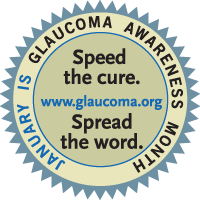Your Monthly Check-Up: January is Glaucoma Awareness Month

Glaucoma, or the “sneak thief of sight,” is the leading cause of preventable blindness in the United States. According to the Glaucoma Research Foundation, more than 2.7 million people in the US over age 40 have glaucoma. The National Eye Institute projects this number will reach 4.2 million by 2030, a 58 percent increase. Glaucoma is called the sneak thief of sight because there are no symptoms and a significant amount of vision can be lost before a diagnosis. Once vision is lost, it is permanent. The World Health Organization (WHO) estimates that 4.5 million people worldwide are blind due to glaucoma.
Glaucoma is a group of eye diseases that involve damage to the optic nerve, gradually causing vision loss without any symptoms. The optic nerve acts as an electric cable that transfers messages from the eye to the brain. Although the most common forms primarily affect middle-aged and the elderly people, glaucoma can affect people of all ages.
According to the Glaucoma Research Foundation:
There are two main types of glaucoma: primary open-angle glaucoma (POAG), and angle-closure glaucoma. These are marked by an increase of intraocular pressure (IOP), or pressure inside the eye. When optic nerve damage has occurred despite a normal IOP, this is called normal tension glaucoma. Secondary glaucoma refers to any case in which another disease causes or contributes to increased eye pressure, resulting in optic nerve damage and vision loss.
While there is no cure, medication or surgery can slow or prevent further vision loss. Suitable treatment depends on the type of glaucoma being treated, among other factors. Early detection is vital to stopping the progress of the disease, and regular comprehensive eye exams are necessary for detecting glaucoma as well as a number of other eye and overall health-related maladies.
“Eye conditions like glaucoma and macular degeneration are best treated when spotted early on,” according to the article “When detecting chronic disease, the eyes have it” in the January/February 2015 issue of Healthy Living Made Simple (published by Sam’s Club). Visiting your optometrist is crucial to maintaining your overall health as many instruments used by optometrists are not used in your primary care physician’s office.
According to the article, many other health conditions can be detected with a retinal scan, including vitamin A deficiency, diabetes, multiple sclerosis, high cholesterol, hypertension, Crohn’s disease, Graves’ disease and juvenile rheumatoid arthritis. A retinal scan is quick, painless and inexpensive – and it provides a highly detailed look at the eye, providing a baseline for future visits.
According to the WHO, glaucoma is the second leading cause of blindness in the world and the leading cause of blindness among African-Americans. Other high-risk groups include people of Hispanic or Asian decent, people over 60, family members of those already diagnosed, diabetics and people who are severely nearsighted. In the most common form, there are virtually no symptoms. Vision loss begins with peripheral or side vision, so if you have glaucoma, you may not notice anything until significant vision is lost. The best way to protect your sight from glaucoma is to get a comprehensive eye examination. Then, if you are diagnosed with glaucoma, macular degeneration or other health concerns, treatment can begin immediately.
The Glaucoma Research Foundation is hard at working searching for a cure for glaucoma and vision loss. For more information, visit www.glaucoma.org as well as the WHO website and the Healthy Living Made Simple article here.
Wellness is an important part of life at Hinda, which is why we dedicate at least one post per month to wellness news and trending topics. What does your company do to promote wellness?














